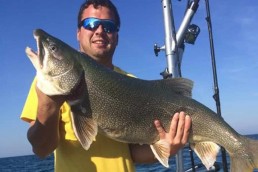Lake Trout Daily Limit for Illinois Unchanged
SHARE THIS POST
As Lake Michigan’s fishery continues to undergo constant changes due to the incidental introduction of exotic species, the fishery experts are still attempting to manage this vast ecosystem.
To recap, the alewives have nearly disappeared, chinook planting has been drastically reduced, wild chinooks are pouring into the lake from Michigan rivers, natural reproduction of lake trout has surged wildly, the forage base cannot support the current glut of predatory fish and scientific research cannot seem to keep pace with the continuously changing habitat.
The initial response to the reduced forage base problem has been to cut chinook planting to the bone and rely on naturally spawned fish to fill the void. The chinook is a four-year eating machine that craves alewives almost exclusively. However, with most of their favored prey clustered in the southern basin of the lake, large segments of the lake are virtually devoid of the big salmon.
Lake trout, which eat about 50 percent fewer alewives than the chinooks, are still abundant around the lake but their large population is taking a big bite out of the available forge base as well. Stocking of lakers has been reduced, with more yet to come, but exploding natural reproduction—being a longtime, elusive goal—is difficult to assess and has been beyond the managers’ ability to control.
To make up for the lack of chinooks, Wisconsin (at five), Michigan (three), and Indiana (three), have raised their daily limits on lake trout, both to mollify anglers and to reduce pressure on the steadily eroding forage base. It was expected that the Illinois DNR would follow suit and increase its current two-lake-trout-per-day regulation. When that didn’t happen, Scott Wolfe, president of Trollers Unlimited, wrote to Vic Santucci, the Illinois DNR’s Lake Michigan program director. He requested information on his plans to change the daily lake trout limit.
Are you enjoying this post?
You can be among the first to get the latest info on where to go, what to use and how to use it!
Here is Santucci’s response:
“I am writing in response to your letter dated July 29, 2016 where you requested that Illinois DNR consider raising the daily bag limit for lake trout to three fish from the current two-fish-per-day limit. To address your request, my office reviewed available data on lake trout populations and the Illinois salmon and trout fishery. After considering these data and our fish-management objectives for Lake Michigan, we have concluded that raising the lake trout bag limit would not be appropriate at this time. Our biggest concerns are that recent reductions in lake trout stocking in southern Lake Michigan (down 700,000-plus fish by 2018), combined with increasing harvest and successful two-fish bag limits in Illinois waters, will result in too few lake trout in our fishery over time. This could put the brakes on the budding rehabilitation success (natural reproduction and survival of wild trout) that we have seen in Illinois in recent years and reduce the number of lake trout available to anglers when other salmon and trout species are not present in our part of the lake. In addition, further declines in stocked lake trout that help sustain our fishery may occur in the near future as we consider eliminating stocking at Julian’s Reef (likely in the next few years) due to recent increases in natural reproduction in Illinois waters.
While our data were very useful in informing our bag limit recommendation, we could better assess the risk of increased harvest on the lake trout population if we had statistical model estimates of lake trout abundance and mortality from a statistical catch-at-age model (SCAA). Research to develop a lake trout SCAA model is currently being considered for funding. With a high likelihood of receiving funding, this research should provide a usable model for our use in two years. We anticipate revisiting lake trout harvest regulations at that time and will be sure to reassess your request for an increase in the bag limit.”
As you can see, there are a lot of ifs, ands and buts affecting Santucci’s ability to come to a firm conclusion regarding the future of the lake trout as well as the chinooks. As swiftly as things are changing out in that huge lake, he and his staff may have their hands full for a long time.
We anglers can only wish them well as we go along for the ride.
MWO
SHARE THIS POST
Did you enjoy this post?
You can be among the first to get the latest info on where to go, what to use and how to use it!
Jerry Pabst
Jerry Pabst has been writing about the outdoors for over 40 years. He captained a Lake Michigan charter boat for 25 years and was inducted into the Fresh Water Fishing Hall of Fame. He has hunted waterfowl in all North American flyways, pursued upland game extensively, and trains his own dogs.



